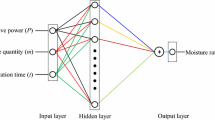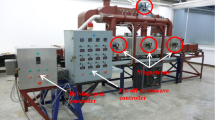Abstract
Response surface methodology, based on Central composite design, was applied to obtain the optimized parameters for microwave drying on anthracite. The microwave power level, drying time, and sample mass were selected as the independent variables for the experiments, while the dehydration ratio was selected as the response affected by the independent variables. The significance of these three variables are in reverse order: drying time ≫ sample mass > power level. The interactions between drying time and power level, power level, and sample mass were significant; the interaction between drying time and sample mass was insignificant. The optimization conditions were the following: power level of 682.07 W; drying time of 2.98 min; and sample mass of 49.19 g. The maximal effectiveness ratio is 1.452 kg/kW h under the optimized condition. The verification experiment indicated that the experimental results were in good agreement with the predicted values, which has only a +0.57% deviation.

Similar content being viewed by others
References
Buragess-Clifford C.E., Narayanan D.L., Van Essemdelft D.T.: The effect of calcinations on reactive milling of anthracite as potential precursor for graphite production. Fuel Process. Technol 90, 1515–1523 (2009)
Ri D.W., Chung B.J., Choi E.S.: Effects of anthracite replacing coke breeze on iron ore sintering. Revue De Metallurgies 105, 248–254 (2008)
Trujic V.K., Zivkovic Z.D.: Influence of addition of anthracite with different particle size on reduction kinetics of magnetite pellets. Mater. Trans 39, 1012–1016 (1998)
Coetzee C.: Improving ilmenite smelting. Ceramic Ind. 159, 29–31 (2009)
Cresswell M.: Coal’s leading role. World Coal 19(49–50), 52 (2010)
Choi Y.C., Lee J.G., Kim J.H., Park T.J., Kim J.H.: High temperature air-blown gasification of Korean anthracite and plastic waste mixture. Th Korean J. Chem. Eng. 24, 706–710 (2007)
Holstein W.L.: Performance of gas saturators in the presence of exit stream temperature gradients and implications for chemical vapor deposition saturator design. Chem. Eng. Sci. 49, 2097–2105 (1994)
Thorpe G.R.: Moisture diffusion through bulk grain subjected to a temperature gradient. J. Stored Prod. Res. 18, 9–12 (1982)
Jia D.H., Afzal M.T.: Modeling the heat and mass transfer in microwave drying of white oak. Dry. Technol. 26, 1103–1111 (2008)
Chauha A.K.S., Srivastava A.K.: Optimizing drying conditions for vacuum-assisted microwave drying of green peas (Pisum sativum L). Dry. Technol 27, 761–769 (2009)
Yaghmaee P., Durance T.: Efficacy of vacuum microwave drying in microbial decontamination of dried vegetables. Dry. Technol. 25, 1099–1104 (2007)
Taira H., Matsui T.: High capacity microwave drying of monolithic refractories in Nippon Steel Corporation. Dry. Technol. 28, 143–148 (2008)
Box G.E.P., Wilson K.B.: On the experimental attainment of optimum conditions. J. R. Stat. Soc. 13, 1–45 (1951)
Myers R.H.: Response surface methodology—current status and future directions. J. Qual. Technol. 31, 30–74 (1999)
Giri S.K., Prasad S.: Optimization of microwave-vacuum drying of button mushrooms using response-surface methodology. Dry. Technol. 25, 901–911 (2007)
Erbay Z., Icier F.: Optimization of hot air drying of olive leaves using response surface methodology. J. Food Eng. 91, 533–541 (2009)
Soysal Y.: Microwave drying characteristics of parsley. Biosyst. Eng. 89, 167–173 (2004)
Aslan N.: Application of response surface methodology and central composite rotatable design for modeling and optimization of a multi-gravity separator for chromite concentration. Powder Technol. 80, 80–86 (2008)
Tan I.A.W., Ahmad A.L., Hameed B.H.: Optimization of preparation conditions for activated carbons from coconut husk using response surface methodology. Chem. Eng. 462, 462–470 (2008)
Author information
Authors and Affiliations
Corresponding author
Additional information
H. Niu and Y. Li contributed equally to this work and should be considered as co-authors.
Rights and permissions
About this article
Cite this article
Niu, H., Li, Y., Lei, Y. et al. Microwave Drying of Anthracite: A Parameter Optimized by Response Surface Methodology. Arab J Sci Eng 37, 65–73 (2012). https://doi.org/10.1007/s13369-011-0165-2
Received:
Accepted:
Published:
Issue Date:
DOI: https://doi.org/10.1007/s13369-011-0165-2




